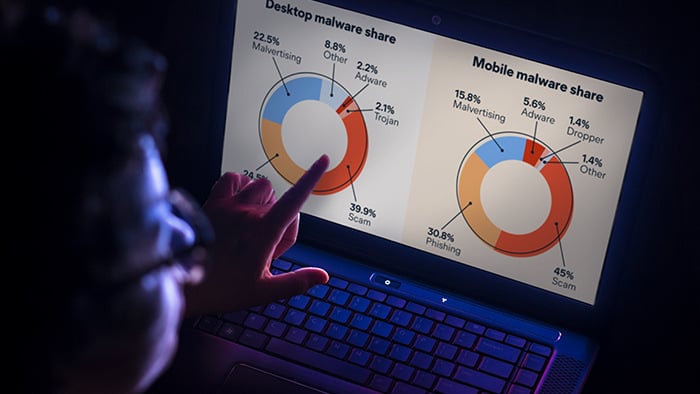Malware vs. virus vs. worm
When distinguishing a computer virus vs. worm, it’s important to understand the larger overall category of malicious software, or malware. Malware refers to all code and applications written to harm devices or the people who use them. Malware is a broad category that includes spyware, adware, ransomware, and several other types. Viruses and worms are two distinct types of malware, but both can spread rapidly.

Inheriting its name from its biological counterpart, a computer virus spreads quickly from device to device. A virus must be attached to a host, such as an executable file or a document. Viruses infect your system, inserting their code into a program or operating system code and borrowing your computer’s resources to copy and spread.
Viruses and worms both cause damage and copy themselves rapidly. The main difference is how they self-replicate, with viruses requiring the help of a host and worms acting independently.
A virus lays dormant in your system until you execute it or take some other required action, such as enabling macros on an infected DOC file. Once activated, the virus inserts its code into other programs on your device to help copy itself, corrupt your files, damage device performance, and spread to additional devices.
While they do share some characteristics with viruses, computer worms are self-sufficient programs that don’t require a host program or file. Thus, worms do not rely on you to trigger them. Many worms can self-replicate and self-propagate without any human activation. This allows worms to spread extremely quickly, often over a local network and sometimes at an exponential rate.
In brief: Viruses and worms both cause damage and copy themselves rapidly. The main difference is how they self-replicate, with viruses requiring the help of a host and worms acting independently.
 Unlike viruses, worms can replicate and spread without any human activation.
Unlike viruses, worms can replicate and spread without any human activation.
While a worm might use a file or program to sneak onto your computer, once it’s in your system, it can spread without the host file and without a human interacting with it at all. A computer worm can also enter your system by exploiting a security vulnerability, which means that you won’t notice it at all. In contrast, a virus spreads from its infected host once it’s been inadvertently activated by the user.
Which is more dangerous?
The impact of both viruses and worms can range in severity from mild to catastrophic.
-
Annoyance: Some viruses and worms present merely annoying messages or pop-ups.
-
Device performance issues: You may notice slow performance, crashing or freezing, changed settings, and things generally not working as they should.
-
Data or money loss; identity theft: Viruses and worms may be able to steal your personal information, leading to identity theft and financial loss.
-
Corporate money loss; brand damage: Businesses can also be hit with viruses and worms, leading to stolen data, repair costs, and damaged reputations.
-
Large-scale, nation-state attacks: Cybercrime is practiced regularly by state-sponsored hacking groups. Viruses, worms, and other forms of malware can damage government institutions and even nuclear weapons sites.
Usually, a worm is more dangerous than a virus, because it can spread more quickly. For example, a worm could infect all of your email contacts. It could then spread to all of your contacts’ contacts, and then your contacts’ contacts’ contacts, and so on, creating exponential growth with extraordinary potential for damage.
Worms can also spread without notifying you or interacting with you at all, such as through a security vulnerability. The worm can detect any device that contains the vulnerability and then insert itself by exploiting that vulnerability.
How do viruses and worms spread?
As mentioned above, viruses require human interaction, such as you executing an infected program, to spread. Worms can spread automatically, without you doing anything. But how do devices first contract a virus or worm infection? Here are the most common ways:
-
Email: The most popular delivery method for malware, email can include infected attachments and malicious links containing viruses or worms.
-
Security vulnerabilities: Developers sometimes accidentally leave vulnerabilities in their code, which hackers exploit to insert malware into your system. A worm can scan a network, find all devices with the vulnerability, and exploit them to gain access.
-
P2P file-sharing: If you download music, movies, or apps from unauthorized sources, you might get more than you bargained for in the download.
-
Malvertising: Websites, even legitimate ones, can contain infected ads in the form of banners or pop-ups. If you click on them, you can unwittingly download a virus or worm. Even if you don’t click, some of these ads can execute a drive-by-download that infects you anyway.
Blended threats
Theoretically, there are clear distinctions between malware vs. viruses (though the later are a subset of the former), viruses vs. worms, spyware vs. adware, and so on. But in the real world, the lines can get blurry when cybercriminals combine aspects of several different threats.
An example of a blended threat would be using a Trojan horse (malicious code disguised as something beneficial) to sneak in a virus.
WannaCry is a real-world example of a blended threat that caused extreme damage around the world. It combined aspects of a worm and ransomware, infecting victims’ computers via EternalBlue, an NSA-developed exploit revealed in 2017 by the Shadow Brokers hacking group.
Once WannaCry infected a victim’s computer through the EternalBlue exploit, it encrypted their files and demanded a ransom to release them. Then, WannaCry scanned the network to find other devices with the same security vulnerability. As soon as it found one, it installed itself on the new device and repeated the process all over again.
WannaCry spread like wildfire, infecting 10,000 PCs every hour.
WannaCry spread like wildfire, infecting 10,000 PCs every hour. Before it was finally halted, WannaCry brought down several high-profile targets, including hospitals, governments, and universities.
Blended threats bring together the worst parts of different cyberthreats, making them some of the most dangerous examples of cybercrime. WannaCry was no exception — experts estimate that it caused up to $4 billion in damage. And that doesn’t include the fear and stress caused when hospitals and governments saw their computer systems locking up right before their eyes.
How to tell if your device is infected
If you think your device might be infected, look for some of these tell-tale signs of malware:
-
Device problems: Slow performance, changed settings, pop-ups, crashes, and freezes can all alert you that something is wrong.
-
Increased power consumption or data charges: Some types of malware drain not only your device’s processor, but also your battery and data allowance.
-
Demands for ransom: If you contract ransomware through a blended threat, it will be obvious, because a screen will pop up telling you that your files are locked until you pay up.
If you notice any of the above issues, it may be difficult to determine whether you have a virus vs. a worm vs. some other type of malware. Luckily, in most cases the cure is the same: you need a strong virus removal tool.
A robust antivirus program like Avast One will scan your device from top to bottom, discover any rogue code, and eradicate it on the spot. No matter if it’s a virus or worm, Avast One will clean up your device in no time. And with six layers of protection and our AI-enhanced cloud-based system, Avast will prevent malware from infecting you in the future.
Malware and Macs
While there’s a pervasive myth out there that Macs can’t get viruses, Macs aren’t immune to malware. Hackers have traditionally focused more of their attention on writing malicious code for PCs simply because there are more PCs on the market.
Mac malware still exists, though, and is increasing rapidly as more cybercriminals experiment with writing Mac-friendly malicious code. If you’re having issues with your Mac, see our guide to remove Mac malware.
Malware and phones
You may be wondering if you can also get a virus on your smartphone. While other types of malware are more common on mobile devices than viruses or worms, there is still a significant risk that your phone or tablet can become infected with malicious code or apps. If you notice issues on your device, see our guides to remove mobile malware.
Malware and hardware
Malware can also infect hardware, such as an internet router, flash drive, or other removable storage devices. If you have a flash drive plugged into your computer while a virus or worm is copying itself and replicating, the malicious code can spread to this hardware as well.
If you notice any malware on your computer or phone, it’s best to check all the other devices on your network to determine if they have been infected as well.
How to protect yourself against viruses and worms
Although viruses and worms have incredible potential for damage, you can prevent them with these safe computing best practices:
-
 Always be vigilant: Be wary of email attachments you weren’t expecting, sketchy links sent through messaging services, and special offers that seem too good to be true (they almost certainly are!). And use a secure browser to stay protected against these and other online threats.
Always be vigilant: Be wary of email attachments you weren’t expecting, sketchy links sent through messaging services, and special offers that seem too good to be true (they almost certainly are!). And use a secure browser to stay protected against these and other online threats.
-
 Update your software regularly: Outdated software can have vulnerabilities that let worms or other malware in. Always apply updates as soon as they become available, including driver updates.
Update your software regularly: Outdated software can have vulnerabilities that let worms or other malware in. Always apply updates as soon as they become available, including driver updates.
-
 Stick to approved app stores: Avoid third-party stores that don’t vet apps or files to make sure they’re safe.
Stick to approved app stores: Avoid third-party stores that don’t vet apps or files to make sure they’re safe.
-
 Use an ad blocker: Malvertising can infect ads that harm your device as soon as you click them or even see them. Install a good ad blocker to avoid this issue altogether.
Use an ad blocker: Malvertising can infect ads that harm your device as soon as you click them or even see them. Install a good ad blocker to avoid this issue altogether.
-
 Get an extra layer of protection: A strong antivirus program will catch anything you miss and remove any viruses that sneak through.
Get an extra layer of protection: A strong antivirus program will catch anything you miss and remove any viruses that sneak through.
Prevent viruses and worms with Avast One
No matter if it’s a virus, worm, or other type of nasty malware, you don’t want it on your device. Avast uses six layers of protection and cloud-based AI to keep hundreds of millions of people safe every day.
In addition to world-class malware prevention, you’ll get extra security and privacy protection for all your devices. We update our software automatically to make sure you get the latest malware defenses in real-time. Get Avast One today for effortless security — completely free.











/What-is-a-macro-virus-Thumb.jpg)


